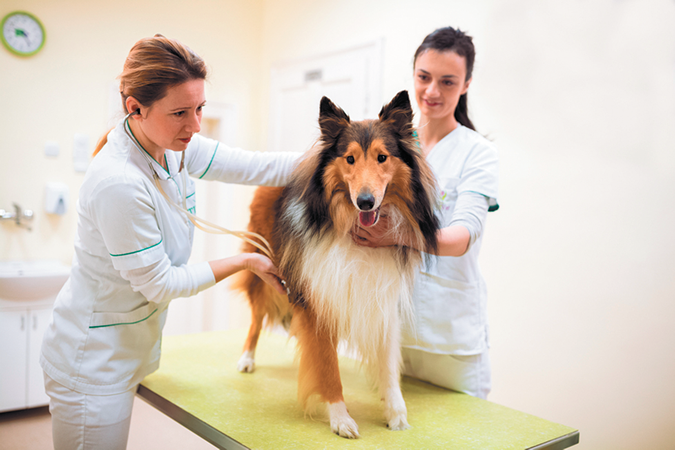If a large dog like a Lab or a golden retriever is rushed to the emergency room after getting hit by a car, he might need four or five units of blood in just a couple of hours. Even a dog who gets heat stroke might need two to four units of plasma (the watery component of blood) before stabilizing. A dog who experiences bleeding complications during an operation is going to need blood, too. Where does all this extra blood come from?
Often, from dogs just like yours. People decide to have their pets become blood donors, and in return for the 10-minute procedure of drawing the blood (at a spot on the neck that gets shaved), the dog will receive a nice treat such as a bowl of wet food plus plenty of petting and cooing by the veterinary staff. All he knows is that he has had a nice outing.
At the Tufts veterinary campus’s Foster Hospital for Small Animals, the blood bank maintains a list of more than 100 people willing to have their dogs donate blood. They come in anywhere from about five times a year to once every six weeks. Many are on a list to be called at a moment’s notice, even in the middle of the night, in case a dog comes in with an emergency and there is not enough banked blood on hand. In exchange for their help, the dogs get their nails clipped, their ears cleaned, or perhaps a good bath, along with the bowl of wet food — kind of like the juice and crackers a person gets after making a blood donation.
Even with all those donors, Tufts sometimes has to buy blood from a national blood bank called Animal Blood Resources. But the purchased blood takes 24 hours to arrive — too long to be of help in an emergency. In addition, shipped blood, while it contains plasma and red blood cells, doesn’t have the platelets that help blood clot. They won’t survive on ice or refrigeration during shipping. That’s why local donors are always needed.
What veterinarians look for in a canine blood donor
First and foremost, your dog has to enjoy going in the car on outings and not mind being in a veterinary facility with other animals and people. At Tufts, if a dog donates blood for the first time and clearly does not enjoy the experience, there’s no second time. There’s no reason to make a dog do this.
Beyond that, different veterinary hospitals have different requirements. At Tufts, for instance, a dog has to be at least a year old and weigh at least 50 pounds to donate blood. He also has to be healthy — free of infections and so on. Greyhounds, pit bulls, and Dobermans undergo additional screenings because they may carry the parasite Babesiosis, which causes a malaria-like disease that can be spread through a blood transfusion. Furthermore, Dobermans are genetically predisposed to Von Willebrand disease, which causes excessive bleeding. If a Doberman has the condition, he cannot be a donor, not only because he could develop excessive bleeding at the collection site but also because his blood will be much less useful to other dogs.
If everything checks out, however, your pet is good to go. Each dog donates one unit of blood at a time, just like a human donor. It comes to just under a pint’s worth, or 10 to 15 percent of a dog’s blood volume altogether — not enough to cause a healthy dog any problems whatsoever.
Are You My Type?
Like people, dogs have a number of different blood types, called Dog Erythrocyte Antigen types, or DEA types. They’re referred to as DEA 1.1, 1.2, 1.3, and so on.
Both our dogs’ blood type and ours are determined by proteins on the surface of the red blood cells called antigens. If you give blood to either species that’s a different type from their own, antibodies from the immune system will attack the foreign red blood cells and destroy them.
But here’s the difference between people and dogs. Dogs do not start out with antibodies to foreign blood types. They build up antibodies only after receiving a blood type different from their own. Thus, generally, if you give a blood transfusion to a dog who has never had one, it will not cause a problem even if the blood type is different — a boon if the blood types on tap are limited. It takes about five days for antibodies to then build up. Future blood donations would have to be a match.






I am interested in having my Labradors donate blood. They are Comfort/therapy dogs, so incredibly easy going.